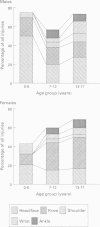Abstract
OBJECTIVE: To establish the demographics of ski injury in relation to age, gender, and perceived cause during a representative season to identify potential injury prevention strategies. SETTING: Blackcomb Mountain, a world class ski resort in British Columbia, Canada. METHODS: Data were collected from the lift ticket records and from ski patrol injury reports for one season, November to May 1991-2. RESULTS: There were 720,066 skier and snowboarder day visits counted by the mountain's lift ticket records, with a total of 2,092 injury reports (incidence 2.91 per 1,000 day visits). Of those with significant injuries (those requiring physician care), 1,210 (58%) were male. The highest injury rate was among children (age 7-12) and teens (age 13-17) with incidences of 3.18 and 3.34 significant injuries per 1,000 skier days, respectively. Head and face injuries constituted 17% and 22% of injuries, respectively in these groups. Overall 22% of head and face injuries were severe enough to cause loss of consciousness or clinical signs of concussion. This was the body region injured most frequently in males. For females over 7 years of age, the knee was the most common site of injury. For youths, the incidence of injuries during school organized activities was 25% higher than during other outings. CONCLUSIONS: The vulnerability of school group participants suggests special education is warranted. The high incidence of head injuries, particularly among young males, needs to be addressed. In light of the high proportion of this group who already wear helmets, the role of helmets in both protection and possible causation of head injury needs objective research.
Full text
PDF



Images in this article
Selected References
These references are in PubMed. This may not be the complete list of references from this article.
- Abu-Laban R. B. Snowboarding injuries: an analysis and comparison with alpine skiing injuries. CMAJ. 1991 Nov 1;145(9):1097–1103. [PMC free article] [PubMed] [Google Scholar]
- Blitzer C. M., Johnson R. J., Ettlinger C. F., Aggeborn K. Downhill skiing injuries in children. Am J Sports Med. 1984 Mar-Apr;12(2):142–147. doi: 10.1177/036354658401200210. [DOI] [PubMed] [Google Scholar]
- Kok G., Bouter L. M. On the importance of planned health education. Prevention of ski injury as an example. Am J Sports Med. 1990 Nov-Dec;18(6):600–605. doi: 10.1177/036354659001800608. [DOI] [PubMed] [Google Scholar]
- Laskowski E. R., Murtaugh P. A. Snow skiing injuries in physically disabled skiers. Am J Sports Med. 1992 Sep-Oct;20(5):553–557. doi: 10.1177/036354659202000512. [DOI] [PubMed] [Google Scholar]
- Matter P., Ziegler W. J., Holzach P. Skiing accidents in the past 15 years. J Sports Sci. 1987 Winter;5(3):319–326. doi: 10.1080/02640418708729785. [DOI] [PubMed] [Google Scholar]
- Myles S. T., Mohtadi N. G., Schnittker J. Injuries to the nervous system and spine in downhill skiing. Can J Surg. 1992 Dec;35(6):643–648. [PubMed] [Google Scholar]
- Pino E. C., Colville M. R. Snowboard injuries. Am J Sports Med. 1989 Nov-Dec;17(6):778–781. doi: 10.1177/036354658901700610. [DOI] [PubMed] [Google Scholar]
- Sherry E., Korbel P., Henderson A. Children's skiing injuries in Australia. Med J Aust. 1987 Feb 16;146(4):193–195. doi: 10.5694/j.1326-5377.1987.tb120195.x. [DOI] [PubMed] [Google Scholar]



